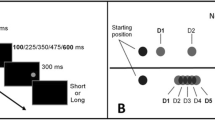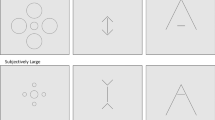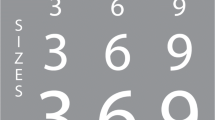Abstract
Magnitudes along different dimensions (e.g., space and time) tend to interact with each other in perception, with some magnitude dimensions more susceptible to cross-dimensional interference than others. What causes such asymmetries in cross-dimensional magnitude interaction is being debated. The current study investigated whether the representational noise of magnitudes modulates the (a)symmetry in space–time interaction. In three experiments using different formats of length, we showed that dynamic unfilled lengths resulted in a higher representational noise than either static unfilled length or static filled length. Correspondingly, we observed that the time-on-space effect was larger for dynamic unfilled lengths than for static unfilled length or static filled length (and it did not differ between the latter two). Further correlational analyses showed that the susceptibility of a target dimension to the influence of a concurrent dimension increased as a function of participants’ representational noise in the target dimension (e.g., the noisier length representations, the larger the time-on-space effect). In all, our study showed that the representational noise of space and time modulates the way the two dimensions interact. These findings suggest that cross-dimensional magnitude interactions arise as a result of memory interference, with noisier magnitudes being more prone to being nudged by concurrent magnitudes in other dimensions. Such memory interference can be seen as a result of Bayesian inference with correlated priors between magnitude dimensions.




Similar content being viewed by others
Data statement
The datasets generated during and/or analyzed during the current study are publicly available in Open Science Framework (https://osf.io/8pvsr/).
Notes
A power analysis (using the "pwr" package in R) on the space-on-time effect in Casasanto and Boroditsky (2008) (with the effect size averaged across experiments) showed that to reach a power of 0.80 at α = 0.05 with two predictors in a multiple regression design requires a minimum of 6 data cells. The design in this and the following experiments (with 25 data cells), thus, clearly exceeds this minimum.
It seems that reproduced durations were the longest in Experiment 3 (where the stimulus duration was defined as the time interval between the two bars) and second longest in Experiment 1. It is likely that more attention was needed to process unfilled lengths in both Experiments 3 and 1, leading to longer apparent durations (e.g., Zakay & Block, 1995); in addition, participants might have inadvertently timed the stimulus duration from the onset of the first vertical bar to the offset of the second vertical bar, hence leading to longer apparent duration. It should be noted that these possible confounds changed the intercept (i.e., longer reproductions across all stimulus durations/lengths) but would have little impact on the slopes (e.g., how reproduced durations changed as a function of stimulus length), which the current paper is interested in.
One might be puzzled by the null difference here given that stimulus duration significantly affected length reproduction in Experiment 2 but not in Experiment 1. Note the effect size being not significantly different between the two experiments simply indicates that the difference in the effect sizes is not large enough to be statistically detectable or meaningful; this finding does not mean that the effect was similarly present or absent in both experiments (i.e., it is still possible that the effect was statistically present in one experiment but not in the other in individual analyses); therefore, the null difference here does not contradict the results from the individual experiments.
References
Agrillo, C., Ranpura, A., & Butterworth, B. (2010). Time and numerosity estimation are independent: Behavioral evidence for two different systems using a conflict paradigm. Cognitive Neuroscience, 1, 96–101.
Alais, D., & Burr, D. (2004). The ventriloquist effect results from near-optimal bimodal integration. Current Biology, 14(3), 257–262.
Allan, L. G. (1979). The perception of time. Perception & Psychophysics, 26(5), 340–354.
Amadeo, M. B., Campus, C., & Gori, M. (2019). Time attracts auditory space representation during development. Behavioural Brain Research, 376, 112185.
Barbaree, H. E., & Mewhort, D. J. K. (1994). The effects of the z-score transformation on measures of relative erectile response strength: A re-appraisal. Behaviour Research and Therapy, 32(5), 547–558.
Besner, D., & Coltheart, M. (1979). Ideographic and alphabetic processing in skilled reading of English. Neuropsychologia, 17(5), 467–472.
Bonn, C. D., & Cantlon, J. F. (2017). Spontaneous, modality-general abstraction of a ratio scale. Cognition, 169, 36–45.
Boroditsky, L. (2000). Metaphoric Structuring: Understanding time through spatial metaphors. Cognition, 75, 1–28.
Boroditsky, L., & Ramscar, M. (2002). The roles of body and mind in abstract thought. Psychological Science, 13, 185–189.
Bottini, R., & Casasanto, D. (2013). Space and time in the child’s mind: metaphoric or ATOMic? Frontiers in Psychology, 4, 803.
Bottini, R., Crepaldi, D., Casasanto, D., Crollen, V., & Collignon, O. (2015). Space and time in the sighted and blind. Cognition, 141, 67–72.
Bottini, R., Guarino, C., & Casasanto, D. (2013). Space is special: A domain-specific mapping between time and nontemporal magnitude. In M. Knauff, M. Pauen, N. Sebanz, & I. Wachsmuth (Eds.), Proceedings of the 35th annual conference of the cognitive science society (pp. 233–238). Austin, TX: Cognitive Science Society.
Bueti, D., & Walsh, V. (2009). The parietal cortex and the representation of time, space, number and other magnitudes. Philosophical Transactions of the Royal Society B: Biological Sciences, 364, 1831–1840.
Cai, Z. G., & Connell, L. (2015). Space–time interdependence: Evidence against asymmetric mapping between time and space. Cognition, 136, 268–281.
Cai, Z. G., & Connell, L. (2016). On magnitudes in memory: An internal clock account of space–time interaction. Acta Psychologica, 168, 1–11.
Cai, Z. G., Connell, L., & Holler, J. (2013). Time does not flow without language: Spatial distance affects temporal duration regardless of movement or direction. Psychonomic Bulletin & Review, 20, 973–980.
Cai, Z. G., & Wang, R. (2014). Numerical magnitude affects temporal memories but not time encoding. PLoS ONE, 9, e83159.
Cai, Z. G., Wang, R., Shen, M., & Speekenbrink, M. (2018). Cross-dimensional magnitude interactions arise from memory interference. Cognitive psychology, 106, 21–42.
Cai, Z. G., Wu, L., & Wang, R. (2020). Cross-dimensional magnitude interactions reflect statistical correlations among physical dimensions: Evidence from space-time interaction. https://osf.io/spmzj/.
Cappelletti, M., Freeman, E. D., & Cipolotti, L. (2009). Dissociations and interactions between time, numerosity and space processing. Neuropsychologia, 47, 2732–2748.
Casasanto, D., & Boroditsky, L. (2008). Time in the mind: Using space to think about time. Cognition, 106, 579–593.
Casasanto, D., & Bottini, R. (2014). Mirror reading can reverse the flow of time. Journal of Experimental Psychology: General, 143(2), 473.
Casasanto, D., Fotakopoulou, O., & Boroditsky, L. (2010). Space and time in the child’s mind: Evidence for a cross-dimensional asymmetry. Cognitive Science, 34, 387–405.
Chang, A. Y. C., Tzeng, O. J. L., Hung, D. L., & Wu, D. H. (2011). Big time is not always long numerical magnitude automatically affects time reproduction. Psychological Science, 22, 1567–1573.
Cicchini, G. M., Arrighi, R., Cecchetti, L., Giusti, M., & Burr, D. C. (2012). Optimal encoding of interval timing in expert percussionists. Journal of Neuroscience, 32(3), 1056–1060.
de Hevia, M. D., Girelli, L., & Vallar, G. (2006). Numbers and space: A cognitive illusion? Experimental Brain Research, 168(1–2), 254–264.
de Hevia, M. D., & Spelke, E. S. (2009). Spontaneous mapping of number and space in adults and young children. Cognition, 110(2), 198–207.
DeLong, A. J. (1981). Phenomenological space-time: Toward an experiential relativity. Science, 213, 681–683.
Dormal, V., Andres, M., & Pesenti, M. (2008). Dissociation of numerosity and duration processing in the left intraparietal sulcus: A transcranial magnetic stimulation study. Cortex, 44, 462–469.
Dormal, V., & Pesenti, M. (2013). Processing numerosity, length and duration in a three-dimensional Stroop-like task: Towards a gradient of processing automaticity? Psychological Research Psychologische Forschung, 77, 116–127.
Dormal, V., Seron, X., & Pesenti, M. (2006). Numerosity-duration interference: A Stroop experiment. Acta Psychologica, 121, 109–124.
Droit-Volet, S., Clément, A., & Fayol, M. (2003). Time and number discrimination in a bisection task with a sequence of stimuli: A developmental approach. Journal of Experimental Child Psychology, 84, 63–76.
Droit-Volet, S., Clément, A., & Fayol, M. (2008). Time, number and length: Similarities and differences in discrimination in adults and children. The Quarterly Journal of Experimental Psychology, 61(12), 1827–1846.
Ernst, M. O., & Banks, M. S. (2002). Humans integrate visual and haptic information in a statistically optimal fashion. Nature, 415(6870), 429–433.
Fischer, M. H. (2001). Number processing induces spatial performance biases. Neurology, 57(5), 822–826.
Gallistel, C. R., & Gelman, R. (2000). Non-verbal numerical cognition: From reals to integers. Trends in Cognitive Sciences, 4, 59–65.
Girelli, L., Lucangeli, D., & Butterworth, B. (2000). The development of automaticity in accessing number magnitude. Journal of Experimental Child Psychology, 76(2), 104–122.
Grondin, S. (2010). Timing and time perception: A review of recent behavioral and neuroscience findings and theoretical directions. Attention, Perception, & Psychophysics, 72(3), 561–582.
Henik, A., & Tzelgov, J. (1982). Is three greater than five: The relation between physical and semantic size in comparison tasks. Memory & Cognition, 10(4), 389–395.
Hurewitz, F., Gelman, R., & Schnitzer, B. (2006). Sometimes area counts more than number. Proceedings of the National Academy of Sciences, 103, 19599–19604.
Javadi, A. H., & Aichelburg, C. (2012). When time and numerosity interfere: The longer the more, and the more the longer. PLoS ONE, 7(7), e41496.
Jazayeri, M., & Shadlen, M. N. (2010). Temporal context calibrates interval timing. Nature Neuroscience, 13, 1020–1026.
Kaufmann, L., Koppelstaetter, F., Delazer, M., Siedentopf, C., Rhomberg, P., Golaszewski, S., et al. (2005). Neural correlates of distance and congruity effects in a numerical Stroop task: an event-related fMRI study. Neuroimage, 25(3), 888–898.
Kranjec, A., Lehet, M., Woods, A. J., & Chatterjee, A. (2019). Time is not more abstract than space in sound. Frontier in Psychology, 10, 48.
Lakoff, G., & Johnson, M. (1980). Metaphors we live by. Chicago and London: The University of Chicago Press.
Lakoff, G., & Johnson, M. (1999). Philosophy in the flesh: The embodied mind and its challenge to western thought. Chicago: University of Chicago Press.
Lambrechts, A., Walsh, V., & van Wassenhove, V. (2013). Evidence accumulation in the magnitude system. PLoS ONE, 8, e82122.
Leibovich, T., Katzin, N., Harel, M., & Henik, A. (2017). From “sense of number” to “sense of magnitude”: The role of continuous magnitudes in numerical cognition. Behavioral and Brain Sciences, 40, e164.
Lourenco, S. F., Ayzenberg, V., & Lyu, J. (2016). A general magnitude system in human adults: Evidence from a subliminal priming paradigm. Cortex, 81, 93–103.
Lourenco, S. F., & Longo, M. R. (2010). General magnitude representation in human infants. Psychological Science, 21(6), 873–881.
Lourenco, S. F., & Longo, M. R. (2011). Origins and development of generalized magnitude representation. In S. Dehaene & E. M. Brannon (Eds.), Space, time and number in the brain: Searching for the foundations of mathematical thought (pp. 225–244). London: Elsevier.
Magnani, B., Oliveri, M., & Frassinetti, F. (2014). Exploring the reciprocal modulation of time and space in dancers and non-dancers. Experimental Brain Research, 232, 3191.
Manyam, V. J. (1986). A psychophysical measure of visual and kinaesthetic spatial discriminative abilities of adults and children. Perception, 15(3), 313-324.3199.
Martin, B., Wiener, M., & van Wassenhove, V. (2017). A Bayesian perspective on accumulation in the magnitude system. Scientific Reports, 7, 1–14.
McGurk, H., & MacDonald, J. (1976). Hearing lips and seeing voices. Nature, 264, 746–748.
Meck, W. H., & Church, R. M. (1983). A mode control model of counting and timing processes. Journal of Experimental Psychology: Animal Behavior Processes, 9, 320–334.
Merritt, D. J., Casasanto, D., & Brannon, E. M. (2010). Do monkeys think in metaphors? Representations of space and time in monkeys and humans. Cognition, 117, 191–202.
Moon, J. A., Fincham, J. M., Betts, S., & Anderson, J. R. (2015). End effects and cross-dimensional interference in identification of time and length: Evidence for a common memory mechanism. Cognitive, Affective, & Behavioral Neuroscience, 15, 680–695.
Nicholls, M. E., Lew, M., Loetscher, T., & Yates, M. J. (2011). The importance of response type to the relationship between temporal order and numerical magnitude. Attention, Perception, & Psychophysics, 73, 1604–1613.
O’Brien, R. M. (2007). A caution regarding rules of thumb for variance inflation factors. Quality & Quantity, 41(5), 673–690.
Oliveri, M., Vicario, C. M., Salerno, S., Koch, G., Turriziani, P., Mangano, R., et al. (2008). Perceiving numbers alters time perception. Neuroscience Letters, 438, 308–311.
Petzschner, F. H., Glasauer, S., & Stephan, K. E. (2015). A Bayesian perspective on magnitude estimation. Trends in Cognitive Sciences, 19, 285–293.
Pufall, P. B., & Shaw, R. E. (1972). Precocious thoughts on number: The long and the short of it. Developmental Psychology, 7(1), 62.
Rammsayer, T. H., & Verner, M. (2015). Larger visual stimuli are perceived to last longer from time to time: The internal clock is not affected by nontemporal visual stimulus size. Journal of Vision, 15, 5.
Riemer, M., Diersch, N., Bublatzky, F., & Wolbers, T. (2016). Space, time, and numbers in the right posterior parietal cortex: Differences between response code associations and congruency effects. NeuroImage, 129, 72–79.
Schlichting, N., de Jong, R., & van Rijn, H. (2018). Robustness of individual differences in temporal interference effects. PLoS ONE, 13(8), e0202345.
Schultz, L. M., & Petersik, J. T. (1994). Visual-haptic relations in a two-dimensional size-matching task. Perceptual and Motor Skills, 78(2), 395–402.
Schulze-Bonsel, K., Feltgen, N., Burau, H., Hansen, L., & Bach, M. (2006). Visual acuities “hand motion” and “counting fingers” can be quantified with the Freiburg visual acuity test. Investigative Ophthalmology & Visual Science, 47(3), 1236–1240.
Spence, C. (2009). Explaining the Colavita visual dominance effect. Progress in Brain Research, 176, 245–258.
Srinivasan, M., & Carey, S. (2010). The long and the short of it: on the nature and origin of functional overlap between representations of space and time. Cognition, 116, 217–241.
Starr, A., & Brannon, E. M. (2016). Visuospatial working memory influences the interaction between space and time. Psychonomic Bulletin & Review, 23, 1839–1845.
Storch, D., & Zimmermann, E. (2019). The effect of space on subjective time is mediated by apparent velocity. Journal of Vision, 19(14), 19–19.
Szűcs, D., & Soltész, F. (2007). Event-related potentials dissociate facilitation and interference effects in the numerical Stroop paradigm. Neuropsychologia, 45(14), 3190–3202.
Thomas, E. A., & Cantor, N. E. (1975). On the duality of simultaneous time and size perception. Attention, Perception, & Psychophysics, 18(1), 44–48.
Thomas, E. A., & Cantor, N. E. (1976). Simultaneous time and size perception. Attention, Perception, & Psychophysics, 19(4), 353–360.
Trommershauser, J., Kording, K., & Landy, M. S. (Eds.). (2011). Sensory cue integration. Oxford: Oxford University Press.
Walsh, V. (2003). A theory of magnitude: Common cortical metrics of time, space and quantity. Trends in Cognitive Sciences, 7, 483–488.
Walsh, V. (2014). A theory of magnitude: The parts that sum to numbers. In R. C. Kadosh & A. Dowker (Eds.), The Oxford handbook of numerical cognition. Oxford: Oxford University Press.
Wearden, J. H., Denovan, L., Fakhri, M., & Haworth, R. (1997). Scalar timing in temporal generalization in humans with longer stimulus durations. Journal of Experimental Psychology: Animal Behavior Processes, 23, 502–511.
Wehrman, J. J., Kaplan, D. M., & Sowman, P. F. (2020). Local context effects in the magnitude-duration illusion: Size but not numerical value sequentially alters perceived duration. Acta Psychologica, 204, 103016.
Winter, B., Marghetis, T., & Matlock, T. (2015). Of magnitudes and metaphors: Explaining cognitive interactions between space, time, and number. Cortex, 64, 209–224.
Xuan, B., Zhang, D., He, S., & Chen, X. (2007). Larger stimuli are judged to last longer. Journal of Vision, 7, 1–5.
Zakay, D., & Block, R. A. (1995). An attentional-gate model of prospective time estimation. In M. Richelle, V. De Keyser, G. d’Ydewalle, & A. Vandierendonck (Eds.), Time and the dynamic control of behavior (pp. 167–178). Liège, Belgium: Universite de Liege.
Zimmermann, E., & Cicchini, G. M. (2020). Temporal context affects interval timing at the perceptual level. Scientific Reports, 10(1), 1–10.
Acknowledgments
This work was supported by a CUHK-University of Manchester (UoM) Research Fund (Seed-corn Fund 2019) and a General Research Fund (14600220).
Author information
Authors and Affiliations
Corresponding authors
Additional information
Publisher's Note
Springer Nature remains neutral with regard to jurisdictional claims in published maps and institutional affiliations.
Rights and permissions
About this article
Cite this article
Cai, Z.G., Wang, R. Cross-dimensional magnitude interaction is modulated by representational noise: evidence from space–time interaction. Psychological Research 86, 196–208 (2022). https://doi.org/10.1007/s00426-020-01472-4
Received:
Accepted:
Published:
Issue Date:
DOI: https://doi.org/10.1007/s00426-020-01472-4




